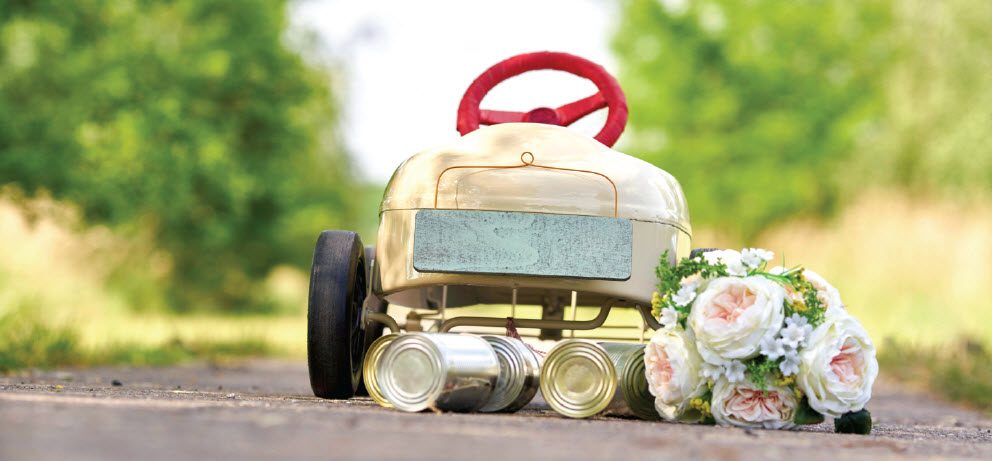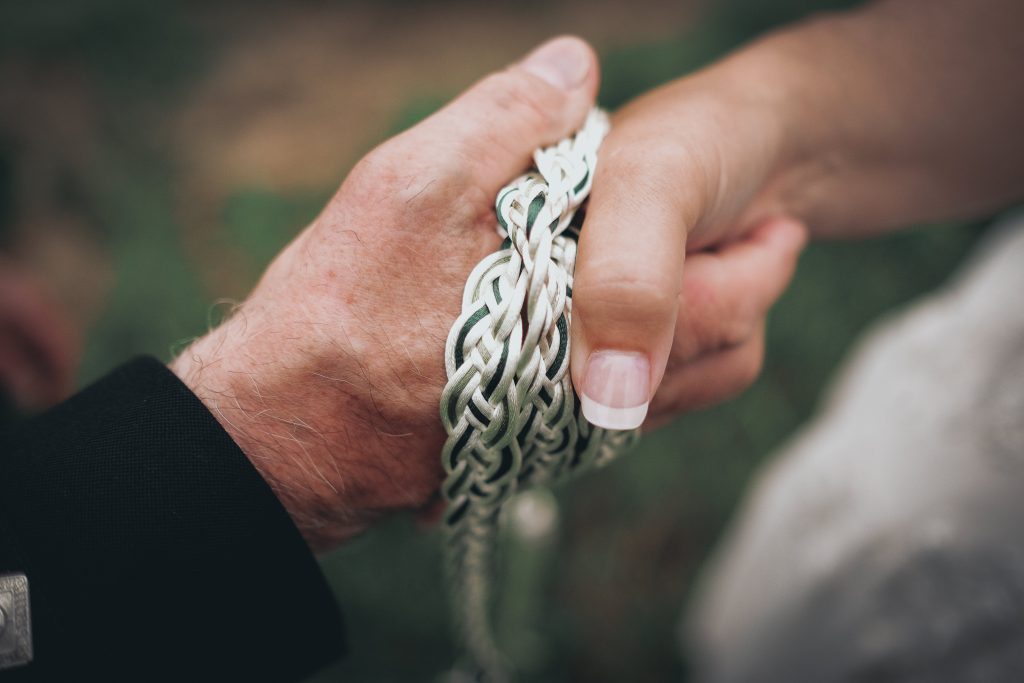The phrase ‘tying the knot’ to describe getting married originates from the ancient Celtic tradition of handfasting, where a couple’s hands were tied together with a cord or ribbon as a symbol of their commitment and union. The knot itself, especially the intricate patterns of Celtic knots, was seen as a symbol of everlasting unity and a way to ward off evil spirits.
Are crystals, cleansings, and energy blessings – mysticism and a touch of Wicca – the new trend for those who are ‘spiritual but not religious’ and tying the knot? Before we apply labels or define this practice as bold, esoteric, or traditional, we might take a moment to consider that almost everything about a modern traditional wedding ceremony is steeped in occult rituals and customs, rooted in the supernatural. From the supportive and large number of wedding attendants to the exchanging of rings…
“Prosperity to the man and happiness to the maid when married in June,”
an ancient Roman proverb.
The most popular time for traditional and eclectic weddings is June and it’s not about the weather, holidays and vacation clubs. June possesses numerological significance, being the sixth month of the year. The ancient Greeks believed a set of six points represented marriage because it is formed by the pairing of two three-pointed triangles: One masculine, the other feminine. Also known as ‘the Star of David’.
The ‘white’ wedding. As we look back at ancient Roman times, the bride wore a white veil not to symbolise her purity or lay testament to her moral fibre, but rather to ward off any unwanted forces or evil spirits. In ancient Greece, the bride was married in white as it was symbolic of joy. Even here in South Africa, in certain tribal cultures, brides paint their bodies in white before the nuptials.
Something old… This originated with the Celts: Wearing an item owned by a happily married woman in the community would activate magic to transfer that happiness to the bride.
Why the trend for a large bridal party? Transported back to ancient Rome, the role of the bridal attendants was to ward off evil spirits who could take away the happiness of the bride. The larger the bridal procession, the greater her protection.
“The ring has long been regarded as the symbol of attainment, perfection and immortality – the last because the circlet of precious metal had neither beginning nor end.” Thus wrote occult scholar Manly P. Hall in The Secret Teachings of All Ages.
The earliest use of wedding rings appears in ancient Hebrew ceremonies and is also found in Greek and Roman culture. In ancient Egypt, a circle was a symbol of eternity drawn in the sand. It morphed into a ring that bound the couple for all time, in both this life and the next.
The sweetest moment.
From the classic, multi-tier traditional wedding cake to a modernist ethnic interpretation, this is one of the most visual, ornate and often most expensive parts of a wedding ceremony that is eaten. In eastern European tradition, the cake is not eaten – it is worn. Bread and cake are sewn into the bride’s clothing, symbolising life and sustenance.
It’s raining rice.
The traditionalists often throw rice over the wedded couple in celebration of the union. Whilst this may be symbolic of abundance and fertility, in ancient Vedic and Chinese cultures rice was thrown to pacify demons and ward off evil.
And for the groom,
The tradition of carrying the bride over the threshold also originated in Rome, where it was believed that the threshold was densely populated by evil spirits and, to protect his bride and thwart their evil intentions, the groom would carry his bride across the threshold.
The magical wedding
The rituals and traditions associated with weddings are highly gendered and extremely heteronormative. They have evolved based on the traditional relationship that existed between a man and a woman since ancient times and, whilst same-sex couples often opt for the same traditional rituals, there are wonderful ways to have a beautiful union of souls with an eclectic ceremony which does not follow gendered lines.
These ideas for magical and soulful ceremonies are perfect for every couple and are gender neutral. The wedding ceremony serves as the launching pad into your marriage and future life together. The more thoughtful and unique you make it, the stronger your foundation will be.
Consulting an astrologer or numerologist to determine an auspicious and fortuitous day as the wedding day has become commonplace.
Diamonds are fast becoming outmoded and current trend indicates that crystals and gems which have different metaphysical properties have become more popular due to their mineral make-up. Emerald has been popularised as it represents the heart chakra. My personal choice, however, was a pink topaz for my wedding ring – a symbol of love and affection that increases the love you have for yourself and your partner. It also promotes openness, honesty and integrity and prompts you to express yourself to your partner in a way that will help your relationship flourish.
Finding a power colour, with both spiritual and auric significance, is very much a part of the magical wedding too.
Anointing the bridal couple with oil infused with herbs associated with grounding and love is a wonderful gift from the wedding party. Those herbs may include rose hips, liquorice root and lemon balm. Jasmine and ylang-ylang are also considered, as they are ethereal, feel like a fairy tale and add a lovely touch.
Another gift from the wedding attendants is to cleanse the aura of the couple with sage. More often than not, a space-clearing of the venue is done before the ceremony.
A morning meditation is a blissful start to the wedding day. Relaxing and connecting to both Source and the essence of who you are is a common practice on the dawning of this magical day.
Receiving energy healing an hour or two before walking down the aisle releases the jitters, calms and opens the heart centre and all of the other energy centres in preparation for the union of souls. Reiki, for example, can be done while the couple is standing up or seated, direct touch is not essential and there is no risk of bridal attire getting crumpled.
The wedding officer is often chosen for their reputation, connectedness to spirit and a deep understanding of the bridal couple’s needs and preferences. They must also be mindful of the families’ sensitivity and possible reluctance with regard to the type of ceremony their dear ones have chosen.
Keeping the magic alive at the reception can be done with crystal grids placed on the tables. Wishes and blessings notes for each guest replace the traditional thank-you notes and they each take a delicate goodie bag away with them. This could include a crystal, a fresh or dried sprig of a significant herb, or a sage bundle. Magically, the recipient will always get the blessings and bag that was meant for them. – Ed
Three popular eclectic wedding ideas
Handfasting
As mentioned in the introduction, it’s the origin of the phrase, ‘tying the knot’. It’s also probably the most universal non-traditional wedding tradition, found in cultures all over the world. The word ‘handfasting’ actually derives from the ancient Celtic practice of tying a couple’s hands together with a ribbon during the ceremony to represent their bond.
This ‘joining’ symbolism is found in many other cultural traditions. Filipino couples are wrapped in a shawl. As depicted in the film My Big Fat Greek Wedding, you know that in Greek tradition, the bride and groom each wear crowns that are connected by a ribbon to represent the joining or binding.
Whatever you use to bind yourselves becomes a keepsake of your commitment since it’s energetically connected and infused with loving intention from your wedding day. The choice of fabric or cord can be very meaningful. I personally used a combination of woven red and blue cord symbolic of both heaven (blue) and earth (red) witnessing the union. The woven cord was bound with feathers and a turquoise crystal at either end, with blue turquoise being all about cleansing energy and bringing good fortune. Many couples use their favourite colours and, in Scottish tradition, the family tartan.
A sand ceremony
Couples who love the ocean and want to bring a piece of the beach into their ceremony, or even have their ceremony on the beach, often have a sand ceremony.
You could talk about some of the symbolic qualities of sand – that it’s used to make concrete, which can stand up to all kinds of ‘weather’. like your marriage! Or that sand can be used to make sandbags, which are a powerful form of protection, intending your union to be protected from the stresses of the world and your union free of burden.
The sand ceremony represents two individuals blending together to become one – a soul union. You’ll need two bottles, jars, or vases – small glass vases of coloured sand (stocked by most craft stores) – and one larger one to empty them into. As you layer the coloured sand and weave together both colours, it is symbolic of the union. When alternating colours, you end up with a wavy, multi-coloured sand creation. Due to the popularity of this practice, sand ceremony kits are available from speciality wedding stores and online.
You can make this ritual more spiritual and personal. One of the ways to do this is to take sand from each of your favourite beaches and blend them together. Just be mindful that beach sand can be sticky, so you may want to add some craft sand for longevity.
Planting a wedding tree
This is a most beautiful ritual for those with a deep connection to Nature and Gaia.
Planting and growing something together is symbolic of the nurturing and care that a marriage needs to be strong and healthy as you grow and blossom as one.
The type of tree that you plant may have powerful symbolism too. You need to contemplate what qualities you want to plant and grow in your union, your life as one. The African yellowwood tree (Afrocarpus falcatus) is often planted at sacred sites to reinforce the significance of the site; symbolic of the significance and sacredness of the union. Birch trees represent new beginnings and cherry trees are symbolic of love. The list is endless; search online for the spiritual properties of trees.
The logistics of planting a tree during the ceremony can be somewhat challenging. The easiest – and least messy – is simply to have a sapling in a decorated pot beside the wedding altar, where you can each add some soil of your own and then water it together. It’s also a mindful way to rekindle the magic of the moment when you transplant it at your home.
The wishing tree
If getting sandy or muddy on your special day is not for you, consider a wishing tree. Select the tree or shrub based on its spiritual properties, plant it in a beautifully decorated pot and place it on a table at the reception with cards, ribbon and pens. Invite your guests to write a wish or blessing on the card and tie it to the tree. This infuses the tree or shrub with all of the well wishes and the cards are a wonderful memento of this sacred union of souls…
Personal wedding vows
In almost every religious tradition, there is no time for the couple to address each other directly in their own words. Generally, you are either repeating words as directed by the officiant or saying “I do.” Writing about your love and your commitment to the other and committing your promises to paper is a powerful exercise and breathtakingly beautiful when spoken to one another, witnessed by heaven and earth and/or all those present at that poignant moment of the ceremony – the union to one.
In the more traditional and religious context, you can certainly refer to a divine power relevant to your chosen religion, but the key to writing your own wedding vows is to make them personal, meaningful and original. Whether you speak them during the ceremony or read them to each other beforehand, this is, unequivocally, the most memorable and moving part of the ceremony.
The most important thing to remember on your special day is that it is your wedding – your day – your way.
And… just to keep all couples considering a soul union in the know, there is a new wedding magazine launching soon. This inspirational magazine will not only feature wedding inspiration, articles and photography related to gowns, venues, divine cakes and other wedding-related topics. The magazine will share information with couples about the stresses of planning a wedding, managing the complexities of blended families and other life changes as two become one. Ed




